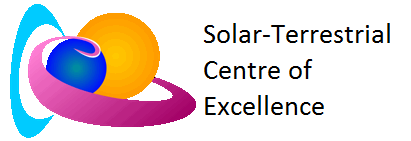Projects
-
T-FORS (Travelling Ionospheric Disturbances Forecasting), Project Ref. No. EU-101081835, doi:10.3030/101081835
Travelling ionospheric disturbances (TIDs) are a specific type of space weather disturbance (propagating waves in the ionosphere) that could compromise the performance of critical space and ground infrastructure. The EU-funded T-FORS project will develop improved models that could aid in issuing forecasts and warnings for TIDs several hours ahead. Machine learning algorithms will be used to forecast the occurrence and propagation of large-scale TIDs. What is more, statistical models will be applied to estimate the occurrence probability and propagation pattern of medium-scale TIDs.
-
PITHIA-NRF (Plasmasphere Ionosphere Thermosphere Integrated Research Environment and Access services: a Network of Research Facilities), Project Ref. No. EU-101007599, doi:10.3030/101007599
A new European project, funded in the Horizon 2020 framework, has started in April 2021 with the RMI as one of twenty-three partners. The PITHIA-NRF project aims at building a European distributed network that integrates observing facilities, data processing tools and prediction models dedicated to ionosphere, thermosphere and plasmasphere research. For the first time, PITHIA-NRF integrates on a European scale, and opens up to all European researchers, key national and regional research infrastructures such as EISCAT, LOFAR, Ionosondes and Digisondes, GNSS receivers, Doppler sounding systems, riometers, and VLF receivers, ensuring optimal use and joint development. PITHIA-NRF is designed to provide organized access to experimental facilities, FAIR data, standardized data products, training and innovation services. Furthermore, the project facilitates drastically research advances in the field of upper atmosphere and near-Earth space, through the integration of data collections from satellite missions and results from key prediction models that can be accessed by scientific users for join exploitation with the data collected from the research infrastructures of the network.
-
Pecasus (Pan-European Consortium for Aviation Space weather User Services)
The PECASUS initiative aims for a global space weather information service center as specified by the International Civil Aviation Organisation in its State Letter released in June 2017. The countries forming the PECASUS consortium are Finland (Lead), Belgium, UK, Poland, Germany, Netherlands, Italy, Austria, and Cyprus. PECASUS will provide civil aviation with information on space weather that has the potential to affect communications, navigation and the health of passengers and crew.The consortium was audited in February 2018 by space weather and operational management experts, nominated by the World Meteorological Organisation (WMO). This audit addressed a broad spectrum of criteria under Institutional, Operational, Technical and Communication & Dissemination categories. PECASUS was declared fully compliant in all criteria with no areas for improvement identified. In its 215th Session the Council of International Civil Aviation Organization has designated three global space weather service centers to be operated by the PECASUS consortium, by United States and by the consortium of Australia, Canada, France and Japan.
- Tech-TIDE (Warning and Mitigation Technologies for Traveling Ionospheric Disturbances), Project Ref. No. EU-776011
- Net-TIDE (Pilot Network for Identification of Travelling Ionospheric Disturbances in Europe), Contract Ref. NATO-SPS-984894
- STCE (Solar Terrestrial Centre of Excellence)
- SWANS (Space Weather and Navigation Systems)
- SIDC-Telescience (Ionospheric Tomography over Belgium Based on Combined GNSS and Ionosonde Measurements)
-
GALOCAD (GALILEO Local Component for nowcasting and forecasting of Atmospheric Disturbances), Contract Ref. GJU/06/2423/CTR/GALOCAD
A new international project – Warning and Mitigation Technologies for Traveling Ionospheric Disturbances (Tech-TIDE) – with RMI ionospheric research team participation and funded by the EU Framework Programme for Research and Innovation (Horizon 2020), commenced in November 2017. Travelling Ionospheric Disturbances (TIDs) are plasma density fluctuations that propagate as waves through the ionosphere at a wide range of velocities and frequencies. TIDs constitute a threat for operational systems using predictable ionospheric characteristics as they can impose significant disturbances in the ambient electron density and Doppler frequency shifts on HF signals. TIDs can have multiple effects in the operation of aerospatial and ground-based infrastructures and especially in the European Geostationary Navigation Overlay Service (EGNOS) and Network Real-Time Kinematic (N-RTK) services, in High Frequency (HF) communications, in radio reconnaissance operations and in Very High Frequency – Ultra High Frequency (VHF-UHF) radiowave propagation. Because of the high occurrence frequency of TIDs (almost daily), and the variety of their characteristics regarding their velocity, propagation direction and amplitude, their identification and tracking is very complicated and has not been achieved in operational service mode. The overarching objective of the TechTIDE project is to design and test new viable TID impact mitigation strategies for the technologies affected and in close collaboration with operators of these technologies, to demonstrate the added value of the proposed mitigation techniques. (view brochure)
A new international project - Pilot Network for Identification of Travelling Ionospheric Disturbances in Europe (Net-TIDE) - with RMI ionospheric research team participation and NATO Science for Peace and Security Programme funding, commenced in November 2014 (NATO HQ News). The objective is to develop a prototype system that provides in real-time an assimilative electron density model of the ionosphere with the required sensitivity to identify and track Travelling Ionospheric Disturbances (TIDs). The system will make use of the existing network of DPS-4D digital ionospheric sounders in Europe which will be trained to diagnose the TIDs applying the Frequency and Angular Sounding (FAS) technique. The FAS technique is based on measuring the variations of the angles-of-arrival and Doppler frequencies of ionospherically-reflected HF radio signals. It offers a possibility of using transmissions from broadcasting stations as probing signals, leading to reduced overall system costs by using a single receiving site to monitor several transmitters making measurements over a large area. The project aims at testing and implementing for the first time a novel experimental technique for identification and tracking TIDs over a specific region, such as Europe, using high precision ionospheric DPS-4D sounders operated by the participating nations. The performance of this technique is expected to be much more reliable than other (indirect) methods since it is based on direct observations, which is one of the novel aspects of the project. This will lead to the development of a robust, effective, and inexpensive system for remote detection and diagnostics of this type of ionospheric irregularities that can provide information and warnings directly exploitable by the users in support of their developments of mitigation techniques.
The Solar Terrestrial Centre of Excellence (STCE) is a project of the Belgian government aiming at the creation and continual support of a centre of international experts in the field of space, solar, and geophysical sciences. The STCE main objective is the integration of the expertise in these sciences of the three leading Belgian institutes (ROB, RMI, BISA) and further consolidation of this expertise via active international cooperation. Another key objective is the valorization of the products and services that are being developed in the frame of the STCE.
The Ionosphere and Space Weather (ISW) Section of the Royal Meteorological Institute (RMI) participates in the STCE project with work package RMI-C "Ionospheric Activity and Effects":
- RMI-C1: Monitoring, modelling, and forecasting the ionospheric activity
- RMI-C2: Ionospheric effects on radiowave propagation, communications and GNSS-based applications
The modern-day society relies heavily on operational technological systems using radio waves: ground-to-ground and ground-to-satellite telecommunications, radars, Global Navigation Satellite Systems (GNSS) such as GPS or GALILEO. Space Weather phenomena are often the origin of disturbed ionospheric conditions which can strongly affect the performances of technological systems based on radio waves. Therefore, it is indispensable to monitor, model and forecast the ionospheric activity and its effects on these technological systems. In 2008, the Royal Meteorological Institute (RMI) launched the project Space Weather And Navigation Systems (SWANS).
The project is primarily concerned with monitoring and research of space weather phenomena and their effects on GNSS-based applications:
- Research on ionospheric plasma structure and dynamics, with emphasis on ionospheric disturbances and effects on Comm/Nav systems
- Development of services to help GNSS users in mitigating the ionospheric effects on GNSS-based applications
Ionospheric tomography is carried out for a 3D reconstruction of the ionospheric plasma density over Belgium based on combined GNSS and ionosonde data. The ultimate goal is to improve the dual-frequency GNSS-TEC calculation technique by refining the computation of hardware biases.
Atmospheric effects on GNSS signal propagation remains an important error source for GNSS applications. In particular, high-accuracy real-time positioning is affected by small-scale irregular structures in the ionospheric plasma or in the neutral atmosphere water vapour. For example, the occurrence of local irregular structures in the atmosphere due to disturbed space weather conditions induce ‘out of tolerance’ errors which is a major concern for Galileo services offering certified accuracy levels to their customers.
The main objectives of GALOCAD are:
- Research on the effects of atmospheric/ionospheric disturbances on the integrity of high-precision GALILEO applications and development of services that can help mitigating such effects.
- Develop a prototype GALILEO local component (over Belgium) which will assess in real time and forecast a few hours in advance, the effects of the atmosphere on GALILEO high accuracy positioning. In other words, this local component will provide tools for GALILEO integrity monitoring with respect to ‘atmospheric threats’ which should lead to improved GALILEO products reliability.

